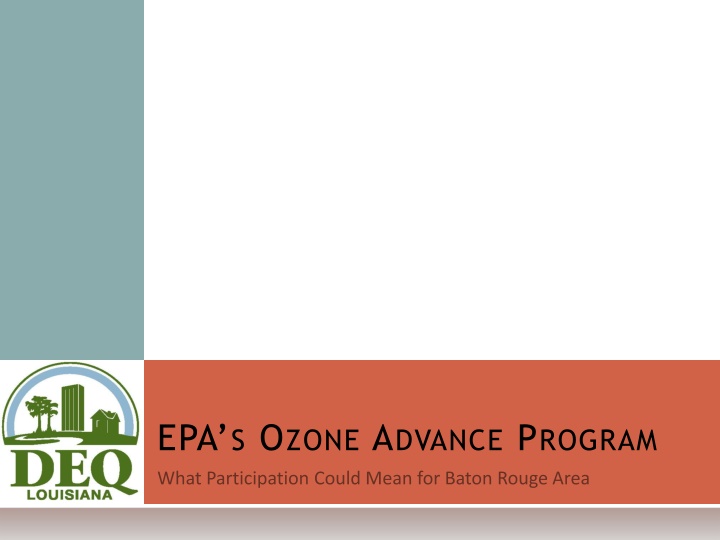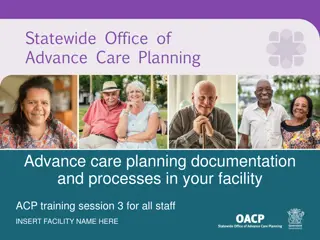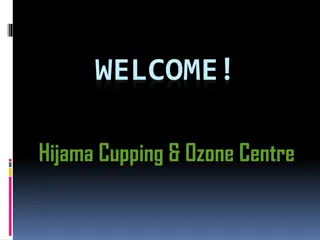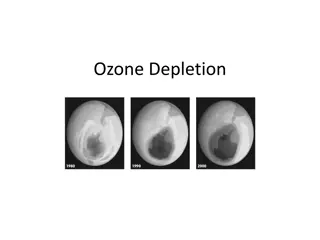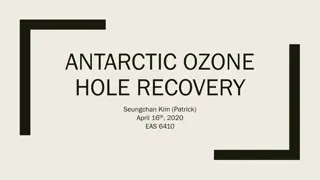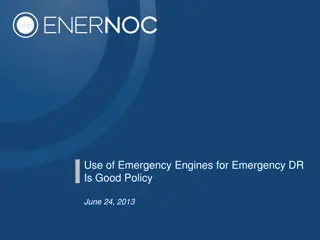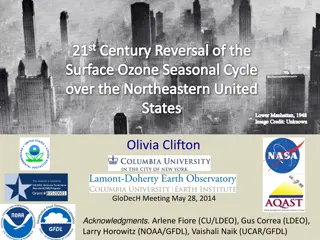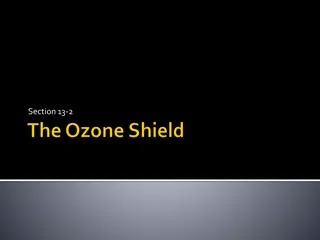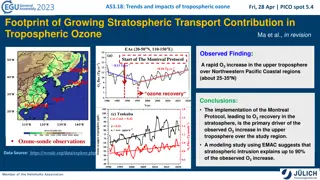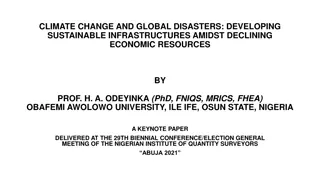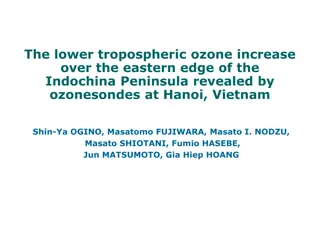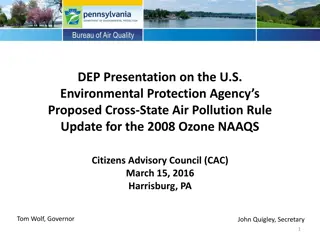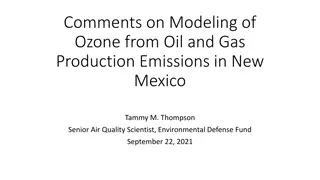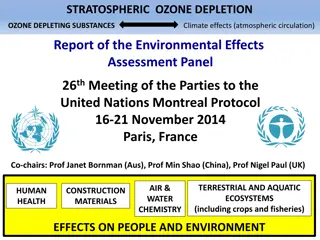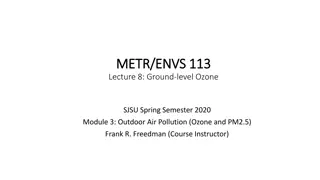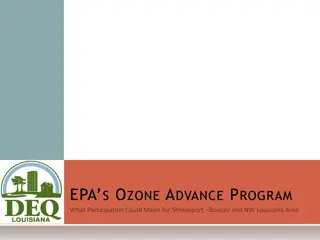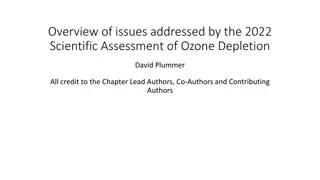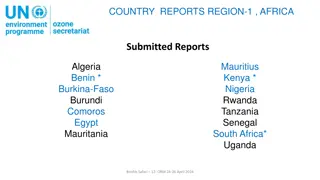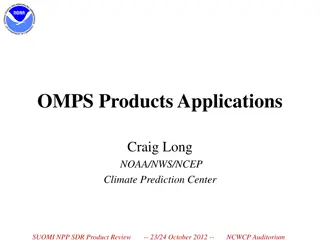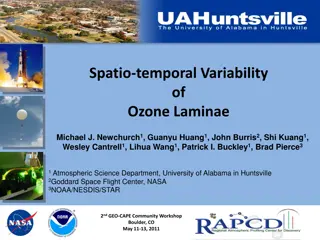EPAS Ozone Advance Program Overview
The EPAS Ozone Advance Program aims to improve air quality in the Baton Rouge area by setting stringent standards for ozone levels. Participants can learn about the 2008 ozone standard, attainment criteria, and potential benefits. The program evaluates design values for ozone concentration to determine attainment, providing valuable insights for participants. Learn how to get started and engage in efforts to reduce NOx and VOC emissions in the area.
Download Presentation

Please find below an Image/Link to download the presentation.
The content on the website is provided AS IS for your information and personal use only. It may not be sold, licensed, or shared on other websites without obtaining consent from the author.If you encounter any issues during the download, it is possible that the publisher has removed the file from their server.
You are allowed to download the files provided on this website for personal or commercial use, subject to the condition that they are used lawfully. All files are the property of their respective owners.
The content on the website is provided AS IS for your information and personal use only. It may not be sold, licensed, or shared on other websites without obtaining consent from the author.
E N D
Presentation Transcript
PRESENTATION OVERVIEW What is the attainment outlook for this area? What is the Ozone Advance Program? Who can participate? What are the criteria for program eligibility? What might you get out of participating? What does participation mean? How do I get started?
WHAT IS THE 2008 OZONE STANDARD Air quality in area continues to improve EPA continues to make standard more stringent Imagine a limbo bar 8-hour primary ozone standard to 75 parts per billion (ppb) is protective of human health 1 ppb is equivalent to 1 drop of water in an Olympic sized pool How is attainment determined? Design Value the 3-year average of the fourth- highest daily maximum 8-hour average ozone concentration measured at each monitor within an area.
DESIGN VALUE CHART 8-hr Design Value as of December 31, 2010 90 85 78 80 75 75 75 7574 74 74 7473 73 73 7372 72 72 7271 71 71 71706968 75 70 6463 65 60 55 50 45 40 35 30 25 20 15 10 5 0
DESIGN VALUE CHART 8-hr Design Value as of December 31, 2011 90 82 85 80 77 77 77 76 76 76 75 75 75 74 74 74 80 72 72 72 72 72 71 70 69 75 67 66 70 65 60 55 50 45 40 35 30 25 20 15 10 5 0
Baton Rouge Area Design Values, 8-Hour DESIGN VALUE CHART 135 129 130 125 125 8-hr Design Value as of December 31, 2010 120 90 85 115 112 78 80 75 75 75 7574 74 74 7473 73 73 7372 72 72 7271 71 71 71706968 75 110 70 6463 105104 65 60 105 10110099 ppb 55 99 99 50 969798 98 100 97 96 95 45 95 40 94 93 35 95 90 91 91 30 9089 89 25 90 87 86 20 15 83 85 10 82 5 8078 0 80 75 70 1980 1981 1982 1983 1984 1985 1986 1987 1988 1989 1990 1991 1992 1993 1994 1995 1996 1997 1998 1999 2000 2001 2002 2003 2004 2005 2006 2007 2008 2009 2010 2011
BATON ROUGE MSA ASCENSION, EAST BATON ROUGE, IBERVILLE, LIVINGSTON, POINTE COUPEEAND WEST BATON ROUGE 2009 Baton Rouge Area NOx Emissions, tpd 2009 Baton Rouge Area VOC Emissions, tpd Area Nonroad Onroad Point Biogenics Area Nonroad Onroad Point Biogenics 3% 7% 24% 19% 4% 55% 13% 58% 12% 5%
WHATIS OZONE ADVANCE? Ozone Advance is a collaborative effort by EPA, states, tribes and local governments to encourage emission reductions in ozone attainment areas, to help them continue to meet the National Ambient Air Quality Standard (NAAQS).
WHAT MIGHT YOU GET OUT OF PARTICIPATING? EPA support Rallying point for public/stakeholder awareness and involvement Framework for action Preferred status for DERA grants, see www.epa.gov/cleandiesel/prgnational.htm Possible recognition Opportunity to highlight measures/programs already underway along with those undertaken as part of Program Stakeholder group formation, engagement
PROGRAM GOALS Help attainment areas take action in order to keep ozone levels below the level of the standard to ensure continued health protection Better position areas to remain in attainment Efficiently direct available resources toward actions to address ozone problems quickly.
WHY SHOULD ATTAINMENT AREAS WORKTO REDUCE OZONE? Ensure continued health protection Less resource intensive to implement measures early More flexibility to pursue a wide range of options Proactive Could better position some areas to stay in attainment If eventually designated, could provide needed reductions that could result in a lower classification and/or that could feed into any eventual SIP EPA could consider early efforts as a factor in exercising for its discretion to redesignate areas not violating in 2008-10 but violating in later years to nonattainment Multi-pollutant co-benefits
WHO CAN PARTICIPATE? States, tribes, local governments Councils of Government Other stakeholders, in conjunction with any of the above Lead participant?
WHAT ARETHE CRITERIA FOR PROGRAM ELIGIBILITY? Area must not be nonattainment for either 1997 or 2008 8-hour standards at the time the they are accepted into the program. Maintenance areas Eventual Marginal areas Local entity should generally identify the area DEQ will identify the monitor(s) that reflect the area s air quality Required emissions inventory reporting should be complete (DEQ handles this)
HOWDO I PARTICIPATE? Submit a letter of intent to EPA prior to initial designations under the 2008 ozone standard Must be received by EPA BEFORE July 20, 2012 Copy LDEQ on your submittal Submit to: Environmental Protection Agency Office of Air Quality Planning and Standards (OAQPS) Attention: Laura Bunte Ozone Advance Program C304-01 109 TW Alexander Drive Research Triangle Park, NC 27711 OR via email to: ADVANCE@epa.gov DEQ will provide a letter template
WHAT DOES PARTICIPATION MEANFOR YOU? Work to Develop a path forward plan within a year Plan should Use best efforts to move quickly toward identifying steps that may reduce ozone levels Implement path forward, measures/programs as soon as possible Collect information as to plan effectiveness Informal status check-ins with EPA at least annually
OTHER IDEAS Ozone Awareness Campaign Meteorologist Training News Spots highlighting ozone
QUESTIONSABOUT OZONE ADVANCE DEQ Vivian Aucoin: vivian.aucoin@la.gov 225-219-3389 Gilberto Cuadra: gilberto.cuadra@la.gov 225-219-3419 Michael Vince: michael.vince@la.gov 225-219-3482 Tim Bergeron: timothy.bergeron@la.gov 225-219-3410 Mailing Address: DEQ Air Permits Division Ozone Advance Program P. O. Box 4313 Baton Rouge, LA 70821
QUESTIONSABOUT OZONE ADVANCE EPA Headquarters Laura Bunte EPA Office of Air Quality Planning and Standards (919) 541-0889 ADVANCE@epa.gov EPA Region 6 Carrie Paige (214) 665-6521 Website: www.epa.gov/ozoneadvance
QUESTIONSABOUTMOBILE SOURCES Rudy Kapichak EPA Office of Transportation and Air Quality (734) 214-4574 kapichak.rudolph@epa.gov
